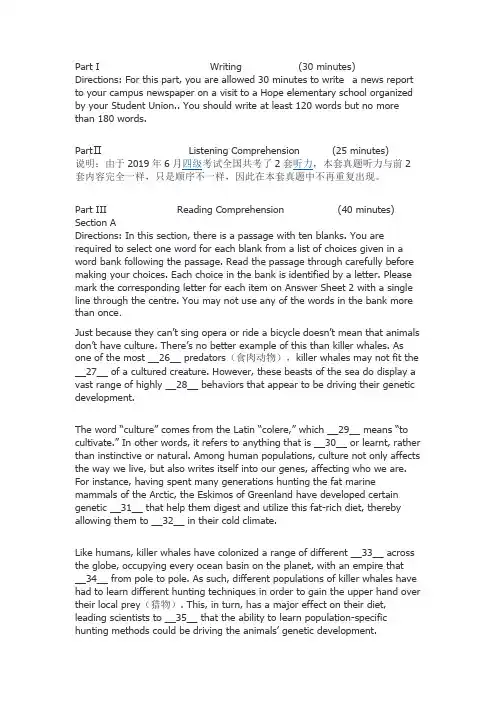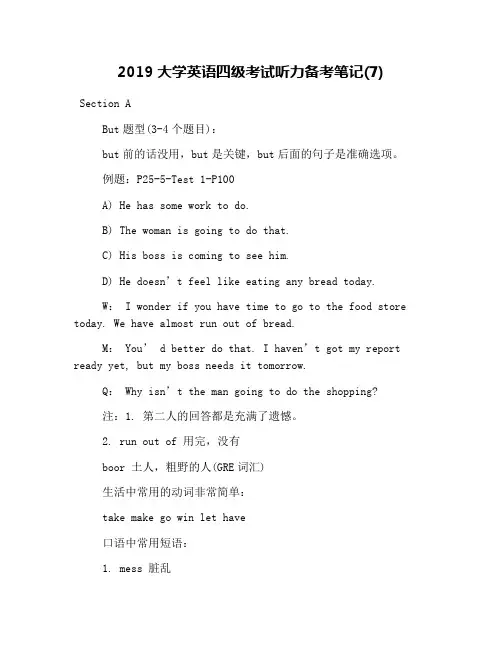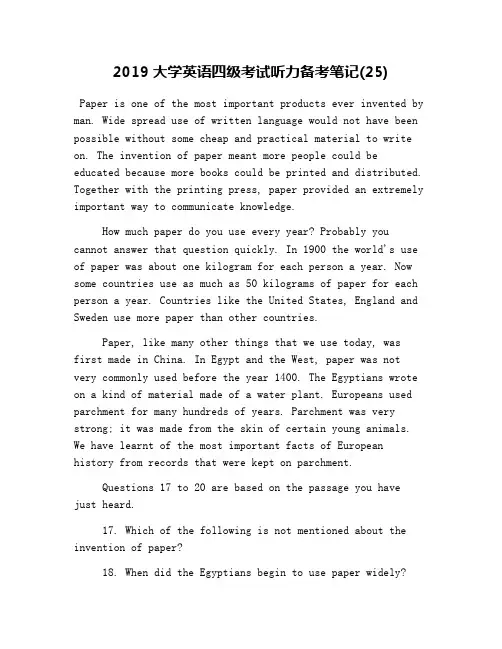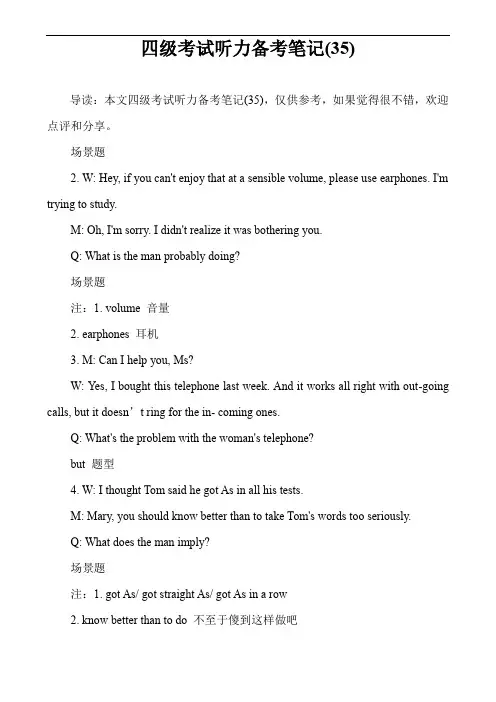2019大学英语四级考试听力备考笔记(31)
2019年6月大学英语四级真题及参考答案(第三套)

Part I Writing (30 minutes) Directions: For this part, you are allowed 30 minutes to write a news report to your campus newspaper on a visit to a Hope elementary school organized by your Student Union.. You should write at least 120 words but no more than 180 words.PartⅡListening Comprehension (25 minutes)说明:由于2019年6月四级考试全国共考了2套听力,本套真题听力与前2套内容完全一样,只是顺序不一样,因此在本套真题中不再重复出现。
Part III Reading Comprehension (40 minutes) Section ADirections: In this section, there is a passage with ten blanks. You are required to select one word for each blank from a list of choices given in a word bank following the passage. Read the passage through carefully before making your choices. Each choice in the bank is identified by a letter. Please mark the corresponding letter for each item on Answer Sheet 2 with a single line through the centre. You may not use any of the words in the bank more than once.Just because they can’t sing opera or ride a bicycle doesn’t mean that animals don’t have culture. There’s no better example of this than killer whales. As one of the most __26__ predators(食肉动物),killer whales may not fit the __27__ of a cultured creature. However, these beasts of the sea do display a vast range of highly __28__ behaviors that appear to be driving their genetic development.The word “culture” comes from the Latin “colere,” which __29__ means “to cultivate.” In other words, it refers to anything that is __30__ or learnt, rather than instinctive or natural. Among human populations, culture not only affects the way we live, but also writes itself into our genes, affecting who we are. For instance, having spent many generations hunting the fat marine mammals of the Arctic, the Eskimos of Greenland have developed certain genetic __31__ that help them digest and utilize this fat-rich diet, thereby allowing them to __32__ in their cold climate.Like humans, killer whales have colonized a range of different __33__ across the globe, occupying every ocean basin on the planet, with an empire that__34__ from pole to pole. As such, different populations of killer whales have had to learn different hunting techniques in order to gain the upper hand over their local prey(猎物). This, in turn, has a major effect on their diet, leading scientists to __35__ that the ability to learn population-specific hunting methods could be driving the animals’ genetic development.A) acquiredB) adaptationsC) brutalD) deliberatelyE) expressedF) extendsG) habitatsH) humbleI) imageJ) litereallyK) refinedL) revolvesM) speculateN) structureO) thriveSection BDirections: In this section, you are going to read a passage with ten statements attached to each statement contains information given in one of the paragraphs. Identify the paragraph from which the information is derived. You may choose a paragraph more than once. Each paragraph is marked with a letter. Answer the questions by marking the corresponding letter on Answer Sheet 2.Living with parents edges out other living arrangements for 18-to 34-year-oldsA) Broad demographic (人口的)shifts is marital status, educational attainment and employment have transformed the way young adults in the U.S. are living, and a new Pew Research Center analysis highlights the implications of these changes for the most basic element of their lives—where they call home. In 2014,for the first time in more than 130 years, adults ages 18 to 34 were slig htly more likely to be living in their parents’ home than they were to be living with a spouse or partner in their own household.B) This turn of events is fueled primarily by the dramatic drop in the share of young Americans who are choosing to settle down romantically before age 35. Dating back to 1880, the most common living arrangement among young adults has been living with a romantic partner, whether a spouse or a significant other. This type of arrangement peaked around 1960, when 62%of the nation’s 18-to 34-year-olds were living with a spouse or partner in their own household, and only one-in-five were living with their parents.C) By 2014, 31.6% of young adults were living with a spouse or partner in their own household, below the share living in the home of their parent(s) (32.1%). Some 14% of young adults lived alone, were a single parent or lived with one or more roommates. The remaining 22% lived in the home of another family member (such as a grandparent, in-law or sibling (兄弟姐妹)), a non-relative, or in group quarters like college dormitories.D) It’s worth noting that the overall share of young adults living with their parents was not at a record high in 2014. This arrangement peaked around 1940, when about 35% of the nation’s 18-to 34-year-olds lived with mom and/or dad (compared with 32% in 2014). What has changed, instead, is the relative share adopting different ways of living in early adulthood, with the decline of romantic coupling pushing living at home to the top of a much less uniform list of living arrangements.E) Among young adults, living arrangements differ significantly by gender. For men ages 18 to 34, living at home with mom and/or dad has been the dominant living arrangement since 2009, In 2014,28% of young men were living with a spouse of partner in their own home, while 35% were living in the home of their parent(s). Young women, however,are still more likely to be living with a spouse of romantic partner(35%) than they are to be living with their parent(s)(29%).F) In 2014, more young women (16%) than young men (13%) were heading up a household without a spouse or parther.This is mainly because women are more likely than men to be sigle parents living with their children. For their part, young men (25%) are more likely than young women (19%) to be living in the home of another family member, a non-relative or in some type of group quarters.G) A variety of factors contribute to the long-run increase in the share of young. Adults living with the parents. The first in the postponement of, if not retreat from, marriage. The average age of first marriage has risen steadily for decades. In addition, a growing share of young adult may be avoiding marriage altogether. A previous Pew Research Center analysis projected that as many as one-in-four of today’s young adult may never marry. While cohabitation(同居)has been on the rise, the overall share of young adults either married or living with an unmarried patner has substantially fallen since 1990.H) In addition, trends in both employment status and wages have likely contributed to the growing share of young adults who are living in the home of their parent(s), and this is especially true of young men. Employed young men are much less likely to live at home than young men without a job, and employment among young men has fallen significantly in recent decades. The share of young men with jobs peaked around 1960 at 84%. In 2014, only 71% of 18-to-34-year-old men were employed. Similarly with earnings, young men’s wages (after adjusting for inflation) have been on a downward trajectory (轨迹) since 1970 and fell significantly form 2000 to 2010. As wages have fallen ,the share of young men living in the home of their parent(s) has risen.I) Economic factors seem to explain less of why young adult women are increasingly likely to live at home. Generally, young women have had growing success in the paid labor market since 1960 and hence might increasingly be expected to be a be to afford to afford to live independently of their parents. For women, delayed marriage—which is related, in part, to labor market outcomes for men—may explain more of the increase in their living in the family home.J) The Great Recession (and modest recovery) has also been associated with an increase in young adults living at home. Initially in the wake of the recession, college enrollments expanded, boosting the ranks of young adults living at home. And given the weak job opportunities facing young adults, living at home was part of the private safety net help young adults to weather the economic storm.K) Beyond gender, young adult’s living arrangements differ considerable by education—which is tied to financial means. For young adults without a bachelor’s degree, as of 2008 living at home with their parents was mor e prevalent than living with a romantic partner. By 2014, 36% of 18-to 34-year-olds who had not completed a bachelor’s degree were living with their parent(s) while 27% were living with a spouse or partner. Among college graduates, in 2014 46% were married or living with a partner, and only 19% were living with their parent(s). Young adults with a college degree have fared much better in the labor market than their less-educated counterparts, which has in turn made it easier to establish their own households.36.Unemployed young men are more likely to live with their parents than the employed.37.In 2014, the percentage of men aged 18 to 34 living with their parentswas greater than that of their female counterparts.38.The percentage of young people who are married or live with a partner has greatly decreased in the past three decades or so.39.Around the mid-20th century, only 20 percent of 18- to 34-year-old lived in their parents’ home.40.Young adults with a college degree found it easier to live independently of their parents.41.Young men are less likely to end up as single parents than young women.42.More young adult women live with their parents than before due to delayed marriage.43.The percentage of young men who live with their parents has grown due to their decreased pay in recent decades.44.The rise in the number of college students made more young adults live with their parents.45.One reason for young adults to live with their parents is that get married late or stay single all their lives.Section CDirections: There are 2 passages in this section. Each passage is followed by some questions or unfinished statements. For each of them there are four choices marked A), B), C) and D). You should decide on the best choice and mark the corresponding letter on Answer Sheet 2 with a single line through the centre.Passage OneQuestions 46 to 50 are based on the following passage.According to the majority of Americans, women are every bit as capable of being good political leaders as men. The same can be said of their ability to dominate the corporate boardroom. And according to a new Pew Research Center survey on women and leadership, most Americans find women indistinguishable from men on key leadership traits such as intelligence and capacity for innovation, with many saying they’re stronger than men in terms of being passionate and organized leaders.So why, then, are women in short supply at the top of government and business in the United States? According to the public, a t least, it’s not that they lack toughness, management talent or proper skill sets.It’s also not all about work-life balance. Although economic research and previous survey findings have shown that career interruptions related to motherhood may make it harder for women to advance in their careers and compete for top executive jobs, relatively few adults in the recent survey point to this as a key barrier for women seeking leadership roles. Only aboutone-in-five say women’s family responsibilities are a ma jor reason why there aren’t more females in top leadership positions in business and politics.Instead, topping the list of reasons, about four-in-ten Americans point to a double standard for women seeking to climb to the highest levels of either politics or business, where they have to do more than their male counterparts to prove themselves. Similar shares say the electorate(选民)and corporate America are just not ready to put more women in top leadership positions.As a result, the public is divided about whether the imbalance in corporate America will change in the foreseeable future, even though women have made major advances in the workplace. While 53% believe men will continue to hold more top executive positions in business in the future, 44% say it’s only a matter of time before as many women are in top executive positions as men. Americans are less doubtful when it comes to politics: 73% expect to see a female president in their lifetime.46.What do most Americans think of women leaders according to a new Pew Research Center survey?A)They have to do more to distinguish themselves.B)They have to strive harder to win their positions.C)They are stronger than men in terms of willpower.D)They are just as intelligent and innovative as men.47.What do we learn from previous survey findings about women seeking leadership roles?A)They have unconquerable difficulties on their way to success.B)They are lacking in confidence when competing with men.C)Their failures may have something to do with family duties.D)Relatively few are hindered in their career advancement.48.What is the primary factor keeping women from taking top leadership positions according to the recent survey?A)Personality traits.B)Family responsibilities.C)Gender bias.D)Lack of vacancies.49.What does the passage say about corporate America in the near future?A)More and more women will sit in the boardroom.B)Gender imbalance in leadership is likely to change.C)The public is undecided about whether women will make good leaders.D)People have opposing opinions as to whether it will have more women leaders.50.What do most Americans expect to see soon on America’s political stage?A)A woman in the highest position of governmen.B)More and more women actively engaged in politics.C)A majority of women voting for a female president.D)As many women in top government positions as men.Passage TwoQuestions 51 to 55 are based on the following passage.People have grown taller over the last century, with South Korean women shooting up by more than 20cm on average, and Iranian men gaining.16.5cm. A global study looked at the average height of 18-year-olds in 200 countries 1914 and 2014.The results reveal that while Swedes were the tallest people in the world in 1914, Dutch men have risen from 12th place to claim top spot with an average height of 182.5cm. Larvian women. Meanwhile, rose from 28th place in 1914 to become the tallest in the world a century later, with an average height of 169.8cm.James Bentham, a co-author of the research from Imperial College, London, says the global trend is likely to be due primarily to improvements in nutrition and healthcare. “An individual’s genetics has a big influence on their height, but once you average over whole populations, ge netics plays a less key role,” he added.A little extra height brings a number of advantages, says Elio Riboli of Imperial College. “Being taller is associated with longer life expectancy,” he said. “This is largely due to a lower risk of dying of cardiov ascular(心血管的)disease among taller people.”But while height has increased around the world, the trend in many countries of north and sub-Saharan Africa causes concern, says Riboli. While height increased in Uganda and Niger during the early 20th century, the trend has reversed in recent years, with height decreasing among 18-year-olds.“One reason for these decreases in height is the economic situation in the 1980s,” said Alexander Moradi of the Universith of Sussex. The nutritional and health crises that followed the policy of structural adjustment, he says, led to many children and teenagers failing to reach their full potential in terms of height.Bentham believe the global rtend of increasing height has important implications. “How tall we are now is strongly influenced by the environment we grew up in,” he said. “If we give children the best possible start in life now, they will be healthier and more productive for decades to come.”51.What does the global study tell us about people’s height in the l ast hundred years?A)There is a remarkable difference across continents.B)There has been a marked increase in most countries.C)The increase in people’s height has been quickening.D)The increase in women’s height is bigger than in men’s.52. What does J ames Bentham say about genetics in the increase of people’s height?A)It counts less than generally thought.B)It outweighs nutrition and healthcare.C)It impacts more on an individual than on population.D)It plays a more significant role in females than in males.53. What does Elio Riboli say about taller people?A)They tend to live longer.B)They enjoy an easier life.C)They generally risk fewer fatal diseases.D)They have greater expectations in life.54.What do we learn about 18-year-olds in Uganda and Niger?A)They grow up slower than their peers in other countries.B)They are actually shorter than their earlier generations.C)They find it hard to bring their potential into full play.D)They have experienced many changes of government55.What does James Bentham suggest we do?A)Watch closely the global trend in children’s development.B)Make sure that our children grow up to their full height.C)Try every means possible to improve our environment.D)Ensure our children grow up in an ideal environment.Part ⅣTranslation (30 minutes) Directions: For this part, you are allowed 30 minutes to translate a passage from Chinese into English. You should write your answer on Answer Sheet 2. 灯笼起源于东汉,最初主要用于照明。
大学英语四级听力历年真题及详细解析

大学英语四级听力历年真题及详细解析大学英语四级考试是国内许多大学的必修课程之一,也是许多学生必须要通过的重要考试。
听力部分是四项考试项目之一,也是许多考生在考试中表现不佳的部分。
因此,本文将介绍大学英语四级听力历年真题及详细解析,以帮助读者更好地了解四级听力的难点和解题技巧,提高考试成绩。
一、历年真题1.2019年12月四级听力真题Section AQuestions 1 to 3 are based on the conversation you have just heard.1. Why did the man choose the job in the first place?2. What did the woman suggest the man do?3. What does the man think of the suggestion?Section BQuestions 4 to 6 are based on the conversation you have just heard.4. What did the man find difficult about learning the language?5. What does the woman think of the way in which the man learnt the language?6. What does the woman suggest the man do to improve his spoken language?Section C7. What is the talk mainly about?8. What kind of music do the following belong to: clave, conga and cowbell?9. Which of the following is NOT mentioned as a feature of salsa music?10. What is the purpose of the talk?二、解析1.2019年12月四级听力真题解析Section AQuestions 1 to 3 are based on the conversation you have just heard.1. Why did the man choose the job in the first place?解析:本题主要考察对于听力材料的理解,题干问为什么男人一开始选择这个工作。
2019大学英语四级考试听力备考笔记(7)

2019大学英语四级考试听力备考笔记(7)Section ABut题型(3-4个题目):but前的话没用,but是关键,but后面的句子是准确选项。
例题:P25-5-Test 1-P100A) He has some work to do.B) The woman is going to do that.C) His boss is coming to see him.D) He doesn’t feel like eating any bread today.W: I wonder if you have time to go to the food store today. We have almost run out of bread.M:You’ d better do that. I haven’t got my report ready yet, but my boss needs it tomorrow.Q:Why isn’t the man going to do the shopping?注:1. 第二人的回答都是充满了遗憾。
2. run out of 用完,没有boor 土人,粗野的人(GRE词汇)生活中常用的动词非常简单:take make go win let have口语中常用短语:1. mess 脏乱His dormitory is in a big mess.2. meet = come across = run into = bang into 遇见。
happen to meet 恰巧碰到3. 与动词搭配使用最多的是out,因为out代表一种极端的状态,很彻底。
run out of 用完了check out 借书;办理出院手续;彻底检查;退房(check in 开房);结帐离开wear out 穿破be worn out (物)破旧;(人)疲惫make out 辨认出figure out 想清楚,弄明白She has a figure that kills. 身材很棒。
2019大学英语四级考试听力备考笔记(25)

2019大学英语四级考试听力备考笔记(25)Paper is one of the most important products ever invented by man. Wide spread use of written language would not have been possible without some cheap and practical material to write on. The invention of paper meant more people could be educated because more books could be printed and distributed. Together with the printing press, paper provided an extremely important way to communicate knowledge.How much paper do you use every year? Probably you cannot answer that question quickly. In 1900 the world's use of paper was about one kilogram for each person a year. Now some countries use as much as 50 kilograms of paper for each person a year. Countries like the United States, England and Sweden use more paper than other countries.Paper, like many other things that we use today, wasfirst made in China. In Egypt and the West, paper was not very commonly used before the year 1400. The Egyptians wrote on a kind of material made of a water plant. Europeans used parchment for many hundreds of years. Parchment was very strong; it was made from the skin of certain young animals. We have learnt of the most important facts of Europeanhistory from records that were kept on parchment.Questions 17 to 20 are based on the passage you havejust heard.17. Which of the following is not mentioned about the invention of paper?18. When did the Egyptians begin to use paper widely?19. Which of the following countries uses most paper for each person a year?20. What is the main idea of this short talk?[P43-Three]topic 题,四个选项中有and应优先考虑题型总结:Section A:1、but 题型2、场景题(线索词)3、替换题(听到什么不选什么)Section B:1、主观题(找积极态度,正面评价)2、客观题(数字题,听到什么选什么)3、宏观题(中心思想题)4、细节题(注意中间的提示词)替换题paraphrase:1、词组与词的替换(一般题干中出现词组;选项中出现词)。
四级考试听力备考笔记(35)

四级考试听力备考笔记(35)导读:本文四级考试听力备考笔记(35),仅供参考,如果觉得很不错,欢迎点评和分享。
场景题2. W: Hey, if you can't enjoy that at a sensible volume, please use earphones. I'm trying to study.M: Oh, I'm sorry. I didn't realize it was bothering you.Q: What is the man probably doing?场景题注:1. volume 音量2. earphones 耳机3. M: Can I help you, Ms?W: Yes, I bought this telephone last week. And it works all right with out-going calls, but it doesn’t ring for the in- coming ones.Q: What's the problem with the woman's telephone?but 题型4. W: I thought Tom said he got As in all his tests.M: Mary, you should know better than to take Tom's words too seriously.Q: What does the man imply?场景题注:1. got As/ got straight As/ got As in a row2. know better than to do 不至于傻到这样做吧5. W: Can you show me how to use this, John?M: It's fully automatic. All you have to do is focus on the scene and press the button here.Q: What are they talking about?场景题注:1. focus on 聚焦2. button 按钮6. M: I think we should move on to the next item.W: OK, but I'd like to take this matter up again at the end of the meeting.Q: What does the woman imply?。
2019年12月四级听力备考资料:Campus life

2019年12月四级听力备考资料:Campus life一、语音问题:连读小练习1. rush hour 高峰时间,尖峰时刻;2. cheer up 使振奋,使高兴;3. check (it) out 借书;办理出院手续;彻底检查;退房(check in 开房);4. travel agent 旅行社(travel agency, travelbureau);financial aid 经济资助;5. turn down 关掉,拒绝;turn on 打开二、口语问题:注意语气,语调,语汇。
例如:1. tape 胶带;cassette 磁带。
2. project 作业(homework, assignment);工程;项目;计划;任务。
3. awful 糟糕的;terrific 特别棒的,好极了(口语中);可怕的,恐怖的(阅读中)。
4. I can tell that. 我能看得出。
5. I understand that... 我听说……。
6. I have got this one. have= have got have to= have got to (gotta)7. must 在口语中表猜测8. I'll take this one. 我要买这个。
9. I won't buy that. = I won't believe that. 我才不信呢。
10. He was my boyfriend.三、考题内容:生活情景,场景会话场景题:如何出考题;判断场景的线索词。
比如:book,校内library;校外book store(线索词manager, order)。
四、解题思路比如:交通:traffic jam车:break down题目分析:but题型:but以后是重点。
这类考题的回答都是:I'd love to, I'd like to, Sounds great, Sounds a lot of fun...... but ......。
2019四级备考:听力课堂笔记(6)
2019四级备考:听力课堂笔记(6)宾馆场景make a reservation 预订房间confirm a reservation 确认预订cancel a reservation 取消预订fully booked / full up / full 客满porter 行旅员tips 小费来源:考试大reception 前台check in 登记入住single room 单人房double room 一张大床的双人房twin room 两张单人床的双人房suite 套房bathroom toilet / w.c closet restroom 厕所room service 客房服务 (四级听力中的客房服务一般只有考一种——送餐)lounge 男士用休息区lobby 大堂business center 商务中心salon 美容厅ball 舞厅bar 酒吧night club 夜总会check out 退房9.邮局场景post / send / mail 寄letter / mail 信registered mail 挂号信regular mail 平信airmail 航空信parcel / package 包裹telegram / cable 电报rate 费率overweight 超重postage 邮资email 电子邮件reply 回复forward 转发cc(carbon copy) 抄送bcc(blind carbon copy)秘密抄送subject 主题attach 附件attachment。
2019年12月英语四六级备考:听力课堂笔记(7)
2019年12月英语四六级备考:听力课堂笔记(7)饭店场景eat out 出去吃take away 外带fast food 快餐book a table 订位子waiter / waitness 服务员waitressmenu 菜单order 点菜appetizer 开胃菜main course 主食dessert 餐后甜点bill 账单service charge 服务费change 找零tips 小费keep the change 不用找零了11.其他closed 关门open 开门office hours / business hours / working hours 工作时间,营业时间关于开关power on / off 开/关turn on / off 开/关switch on / off 开/ 关 (这个词只能用于与电相关的开关,不能用于水龙头之类的开关)干杯cheerspropose a toast tobottom upthe best book 的书圣经the best thing 的事情选择the last thing 最不愿意做的事情the last man 最不愿意见的人best seller 畅销的东西sell up 卖完,卖光售罄sell out卖完,卖光售罄 / 出卖朋友或原则sell off 低价处理库存商品selling machine 自动售货机selling point 卖点count the days 渴望count on = dependent / rely on depend on count in 把……考虑在内count for nothing 一钱不值count for little 无足轻重count for much 举足轻重count down 倒计时本文来源:考试大网count up 相加count up to 共计。
最新大学英语四级考试复习资料阅读及完形填空(2019年9月更新)
最新大学英语四级考试复习资料(2019年更新)第三、四部分·阅读及完形填空阅读笔记(一):一、大纲的要求对主体细节推理以及态度题有所把握,对阅读速度的要求:每分钟70 个单词。
二、四级文章本身的特点:1、结构:1)文科文章常有的一些结构A、现象解释型(文章一开始给出一个现象然后对现象进行解释,一般都会在第一段的末句是一个问句,段末是问号。
就是要我们寻找回答,问题就是一个现象,我们就要寻找解释,来做主题。
)解释即为文章的主题所在。
常被考到的有:现象本身;解释;作者对解释的评价。
理科文章解释主题常有两种方式:1)罗列式的2)用实验来解释主题文中加引号的词,表明该词在原文中有特定的含义,表达并非最表面的意思问题中出现了一开始就提到的现象时,答案通常针对文章主题。
B、问题解决方案型(文章一开始给出一个问题,对问题给出一个解决方案。
典型的文章:2001 年6 月的第一篇文章。
问题—problem 第一问题本身考一道题,第二造成问题的原因是,第三问题的解决方案是,第四作者对解决方案的态度,正评价还是副评价,肯定还是否定。
思路比较固定,只要是解决方案一般都是不行的。
)C、结论解释型(在文科文章的数量是最大的。
文章一开始给出一结论,然后对结论进行解释,数量极多。
)2)理科文章的结构A、现象解释型(结构与文科文章不一样,理科文章首句出问号,常暗示指现象,有现象就要寻找解释。
)B、问题解决方案型(成果型在理科文章里很多,2001-6)C、实验型文章(文科文章可以颠三倒四的把问题反复地说,理科文章一般比较客观,要说明问题一般用实验来说。
)2、体裁:以说明和议论为主。
原因:四级和四级以上的文章具有的特征——academic 学术性的,学术性的文章用记叙文说不清楚,只能用说明和议论。
说明文:作者没有太多的观点,只给出一些数据和事实,让你自己去推理、综合。
启发:1)、关注重点不同。
对于说明文而言注意文中的定义、概念、重要数据和细节。
2019年12月大学英语四级听力词汇分类:学习类
2019年12月大学英语四级听力词汇分类:学习类2018年12月大学英语四级听力词汇分类盘点英语四级听力词汇分类:学习类apply for 申请business degree 商学院学位pay your own way 自己支付各种费用semester 学期(美国英语)biology 生物学term 学期(英国英语)registration 注册course 课程class permit 听课证optional course 选修课literature class 文学课professor 教授briefing 剪报lecturer 讲师barely stay awake 几乎不能保持清醒complicated 复杂extra copies 多余的篇子informative 信息量大presentation 陈述,解释,示范mission 任务,使命nervous 紧张的contest 比赛calm 平静的contestant 参赛选手a large audience 一大群观众talk of the town 镇上谈论的焦点shaking all over 浑身发抖not a big deal 不是什么大不了的事情beyond me 超出我的理解范围reading assignment 阅读任务selectively 有选择地chapter by chapter 一章一章地theory 理论read through 从头到尾地读plot 情节cover a few chapters 涉及了几个章节intensively 精细地character 人物角色typing errors 打字错误revise 修订quality paper 好纸get it published 出版proofread 校对paragraph 段落final exam 期末考试fail 不及格,失败mid-term 期中考试results (pl) 分数stay up 熬夜release 发布(分数)two sleepless nights 两天两夜没睡觉be through with 结束,完成2018年12月大学英语四级听力词汇分类盘点。
- 1、下载文档前请自行甄别文档内容的完整性,平台不提供额外的编辑、内容补充、找答案等附加服务。
- 2、"仅部分预览"的文档,不可在线预览部分如存在完整性等问题,可反馈申请退款(可完整预览的文档不适用该条件!)。
- 3、如文档侵犯您的权益,请联系客服反馈,我们会尽快为您处理(人工客服工作时间:9:00-18:30)。
2019大学英语四级考试听力备考笔记(31)
[P30-4]
A) He knows more than the woman does.
B) What the woman said is true.
C) What the woman said is wrong.
D) Some people pretend to know what they really don't.
W: Some people know a lot more than they tell.
M: Unfortunately the reverse is also true.
Q: What does the man mean?
注:the reverse is also true 反之亦然 =vice versa
[P33-1]
A) No, it's open only to teachers and postgraduates.
B) Yes, but he needs the approval by his professor.
C) Yes, because he is a senior student.
D) Yes, he can study there if he is writing a research
paper.
M: Hello, I'm a senior student. Could you tell me
whether this reference room is only for faculty members?
W: No, it's also open to the postgraduates; and
undergraduates can come too if they've got professors'
written permission.
Q: Can the man study in the reference room?
注:faculty members 教职员工总称。faculty 才能 参见[P39-
3]
建议题型
第一个人有麻烦时,第二个人回答如果知道如何解决则提出一个
建议,如果不知怎么办则安慰第一个人。
建议本身就是答案。
表示安慰:
Don't worry. Never mind. Take it easy. Calm down.
表示建议:
You should . You ought to (oughta) ...
Shouldn't you比you should 语气强烈的多
Why not ... Why don't you ...
How about ... What about ...
If I were you I would ... = You should ...
had better Let's ...
Is there anything wrong with ...
